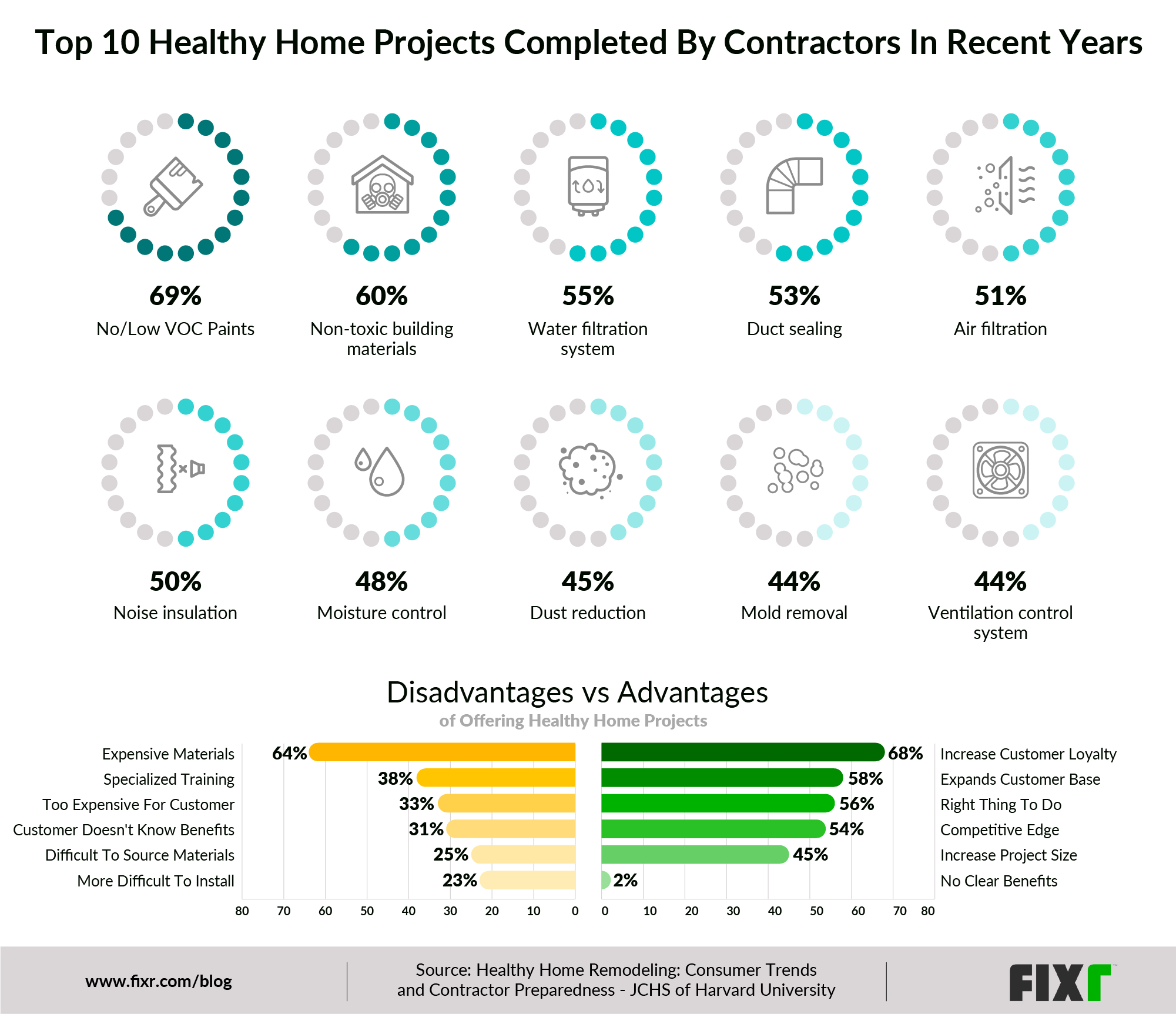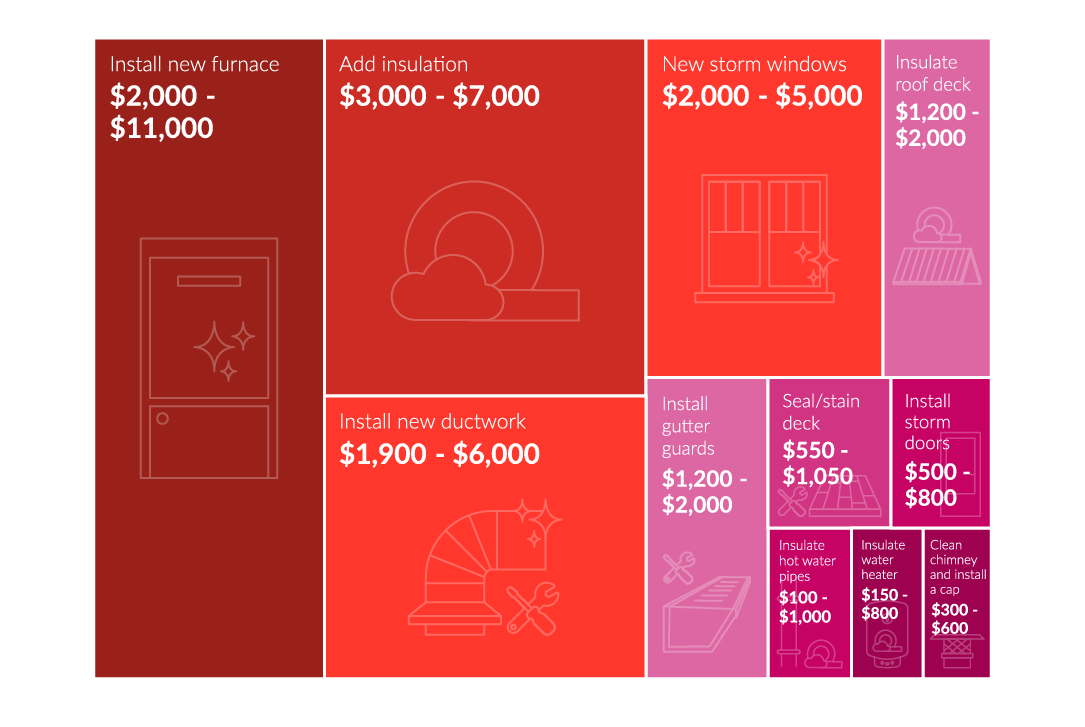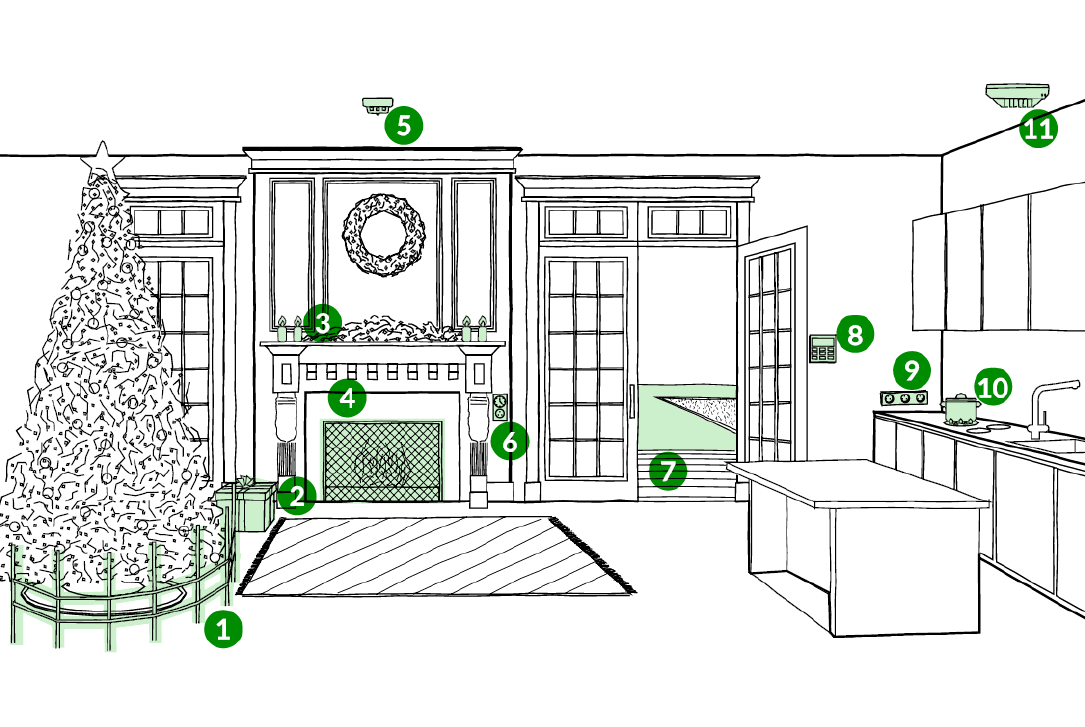Homeowners are increasingly concerned about how their home’s environment could be negatively affecting their well-being. In fact, a joint 2019 study conducted by Harvard University and the Farnsworth Group reported that 30 percent of all U.S. households “expressed concerns about some aspect of their home posing a risk to their health.” This has led many homeowners to reach out to contractors in the hopes of improving the health of their home through remodeling projects aimed at improving the health quality of their residences.
We took a look at the healthy home projects most commonly completed by contractors in recent years, as well as the advantages and disadvantages for contractors offering them. We compiled these results into an easy-to-read graphic, so you can see the types of projects that homeowners are requesting, and the impacts of those projects on the ones completing them.

Understanding What Makes Healthy Homes
From the source listed above, Fixr took a look at the various projects that were most requested by homeowners and completed by contractors over the last few years. Our visualization lays them out based on how frequently they are completed. Low/no VOC paint was requested and used in 69% of all completed projects, while ventilation control systems made up just 44% of projects.
However, homeowners aren’t the only ones impacted by these findings or by the types of projects being requested. Contractors who are carrying out these jobs or who are considering offering them are equally, if not more, impacted by this popularity in healthy home projects.
Therefore, the graphic also lists the top advantages and disadvantages to contractors who want to offer these types of services to their clients. For example, while 64% reported that these materials are more expensive, 68% said that it also increased consumer loyalty. It’s easy to see from this graphic that the advantages do outweigh the disadvantages across the board. While the listed disadvantages should be considered, most contractors may find that the positives of offering these types of services will far outweigh the negatives in the long term.
A Closer Look At How Homeowners Create Healthy Homes
Most of the projects that made the top 10 list of the most common healthy home projects seem to have a lot in common. The majority of them involve home air quality testing and improving the indoor air quality of the home. This includes the use of materials like low/no VOC paints, duct sealing, air filtration, and dust reduction. While there are numerous methods for conducting a home air quality test, there’s no doubt doing so is the most important consideration for homeowners since so many projects revolve around improving the home’s air quality.
How To Test The Air Quality In Your Home
You can test the air quality in your home by yourself or you can hire a contractor to do it. To conduct the test yourself, you need to check for the following:
- Dust and allergens in the air
- Carbon monoxide
- Radon gas
There are different devices you can purchase to monitor these elements, including air quality monitors, carbon monoxide detectors, an at-home radon test, and air quality monitors designed to pick up levels of dust and allergens in the air. You may also want to buy an air purifier to clean your home’s air on an ongoing basis, and to swap out the filters in your HVAC system for models designed to capture more particulates, and change them more frequently as well.
Monitoring all of this data can be a little overwhelming if you’re not sure what exactly you’re looking for, so hiring a company who specializes in air quality improvement to check air quality in your home is a guaranteed way to receive accurate results. These companies will also be able to give you suggestions and actionable advice on how to improve the air quality in your home.
Another interesting finding is the emphasis homeowners place on high noise reduction. Noise in and of itself isn’t necessarily linked to poor health outcomes, but noise reduction can make a home more comfortable and is linked to lower stress levels. In fact, the World Health Organization does recommend reducing the amount of environmental noise to help lower stress levels. Even though noise control may seem like an outlier in the visualization, it can have a profound effect on the health of the home.
Home moisture control is also one of the top concerns when improving the health of a home because moisture is often linked to mold. Since mold removal is also within the top 10, and reducing mold is linked to better air quality, it also makes sense that moisture control would rank within the top 10, too. One of the most accurate ways to monitor moisture levels in your home is to invest in a home moisture meter.
Surprising Advantages for Contractors
The positive and negative attributes of these types of projects for the contractor are also visualized, and while most of the disadvantages are expected - the materials are most costly and specialized training can be difficult to come by - there are a few surprising advantages as well.
The first advantage is the increase in project size. 45% reported an increase in project sizes when including healthy home projects. Homeowners and contractors alike often see these types of projects as expensive on their own, but adding them to existing projects can help average out the cost. Completing multiple projects at the same time will add convenience for the homeowner and increase the total project size, which is a definite plus for contractors.
The expanded customer base is also an advantage, as is a better competitive edge, and an increase in customer loyalty. Also of interest is the fact that many contractors (56%) feel that simply offering this type of material or project to their customers is the right thing to do. This is separate from any tangible gain the contractors may receive, but since merely offering the option does not mean customers need to take advantage. Offering may risk nothing for the contractor.
Healthy Home Tips And Guidelines
It seems that the advantages for both the contractor and the homeowner are clear, but that doesn’t mean that each of these projects is always the best way to proceed. Using healthier materials is linked to a higher project cost, so homeowners wanting to embark on a healthier home should weigh the costs carefully against the expected outcome. Homeowners who need to improve home air quality, remove mold, and decrease moisture in the home, and other problems may see a greater benefit than homeowners who are not currently experiencing these issues.
Healthy home products may also be more difficult both to source and to install, so homeowners will want to make sure that their contractor is aware of these issues up front, and has a clear source and the necessary training before proceeding. Otherwise, the project may encounter some delays that were not previously planned for.
Finally, make sure that you know the expected benefits of each project you plan to undertake. Sometimes advertising for a material or product may not tell the whole story, while some homes may not gain as many benefits as others.
Healthy Living At Home
Knowledge and information are the first steps to a better understanding of how you can improve the health of your home. Whether you’re planning a remodel and want to include some healthier materials, you are currently experiencing problems with your home, or you’re a contractor who wants to offer more options to your client base, we hope that these findings will assist you with your next project. Make sure you pay attention to the potential benefits and disadvantages of these types of projects to make the most informed decision possible for your home.




